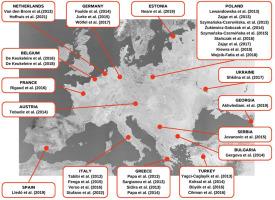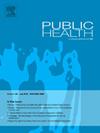Seroprevalence of tick-borne diseases in Europe in occupational settings: A systematic review and metanalysis
IF 3.2
3区 医学
Q1 PUBLIC, ENVIRONMENTAL & OCCUPATIONAL HEALTH
引用次数: 0
Abstract
Objectives
Tick-borne diseases (TBDs) pose a growing occupational risk due to the expanding geographical range of tick species and their associated pathogens. This study aims to assess TBD seroprevalence among different occupational groups in Europe, identifying high-risk professions and guiding targeted prevention efforts.
Study design
A systematic review and meta-analysis were conducted following PRISMA guidelines to evaluate TBD seroprevalence in occupational settings across Europe from January 2013 to June 2024.
Methods
A comprehensive search of PubMed, Web of Science, and Scopus identified 36 relevant studies. Heterogeneity among studies was assessed using Cochran's Q test and the inconsistency index (I2), with sensitivity and outlier analyses applied to evaluate their impact. Publication bias was examined through funnel plot analysis, Egger's test, and Duval & Tweedie's trim-and-fill method.
Results
Seroprevalence varied significantly across occupations. The highest rates were found for Coxiella burnetii among livestock and dairy producers (up to 73.7 % in Italy) and Borrelia burgdorferi among forestry workers, particularly in Poland. A meta-analysis of 33 studies revealed seroprevalence rates of 8.2 % in military workers (no publication bias), 26.0 % in forestry workers, 8.0 % in veterinarians, and 18.0 % in farmers, with high overall heterogeneity.
Conclusions
TBD risk is influenced by occupational exposure, environmental factors, and regional differences. Given the substantial variation across worker categories, targeted preventive measures, increased awareness, and enhanced surveillance efforts are necessary to mitigate risks in high-exposure professions.

欧洲职业环境中蜱传疾病的血清患病率:系统回顾和荟萃分析
目的随着蜱类及其相关病原体的地理分布范围的扩大,蜱传疾病(tds)构成了日益严重的职业风险。本研究旨在评估欧洲不同职业人群的TBD血清患病率,确定高危职业并指导有针对性的预防工作。研究设计遵循PRISMA指南进行系统回顾和荟萃分析,以评估2013年1月至2024年6月欧洲职业环境中TBD的血清患病率。方法综合检索PubMed、Web of Science、Scopus等相关文献36篇。采用Cochran’s Q检验和不一致性指数(I2)评估研究间的异质性,采用敏感性和离群值分析评估其影响。通过漏斗图分析、Egger’s检验和Duval & Tweedie’s trim- fill法检验发表偏倚。结果不同职业的血清患病率差异显著。在畜牧业和乳制品生产者中发现伯氏柯谢氏菌感染率最高(在意大利高达73.7%),在林业工人中发现伯氏疏螺旋体感染率最高,特别是在波兰。对33项研究的荟萃分析显示,军人的血清阳性率为8.2%(无发表偏倚),林业工人为26.0%,兽医为8.0%,农民为18.0%,总体异质性较高。结论stbd风险受职业暴露、环境因素和地区差异的影响。鉴于工人类别之间存在巨大差异,有必要采取有针对性的预防措施,提高认识并加强监测工作,以减轻高暴露职业的风险。
本文章由计算机程序翻译,如有差异,请以英文原文为准。
求助全文
约1分钟内获得全文
求助全文
来源期刊

Public Health
医学-公共卫生、环境卫生与职业卫生
CiteScore
7.60
自引率
0.00%
发文量
280
审稿时长
37 days
期刊介绍:
Public Health is an international, multidisciplinary peer-reviewed journal. It publishes original papers, reviews and short reports on all aspects of the science, philosophy, and practice of public health.
 求助内容:
求助内容: 应助结果提醒方式:
应助结果提醒方式:


